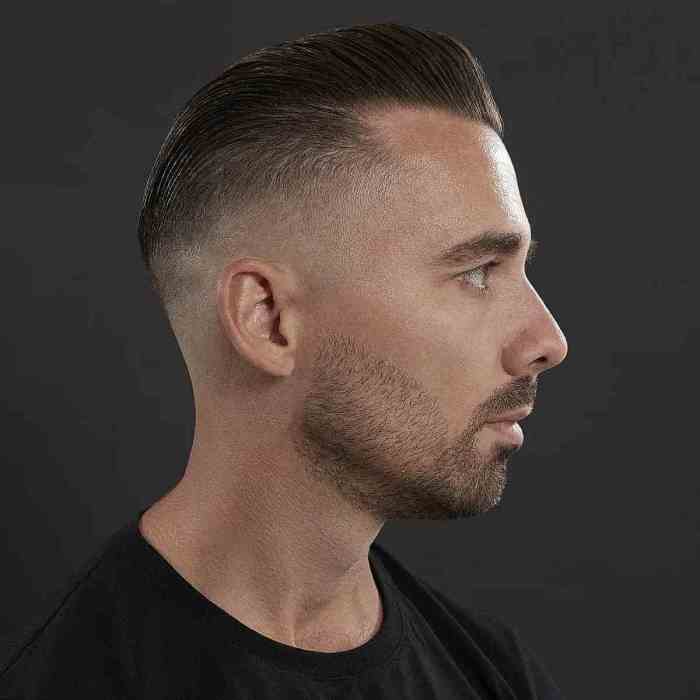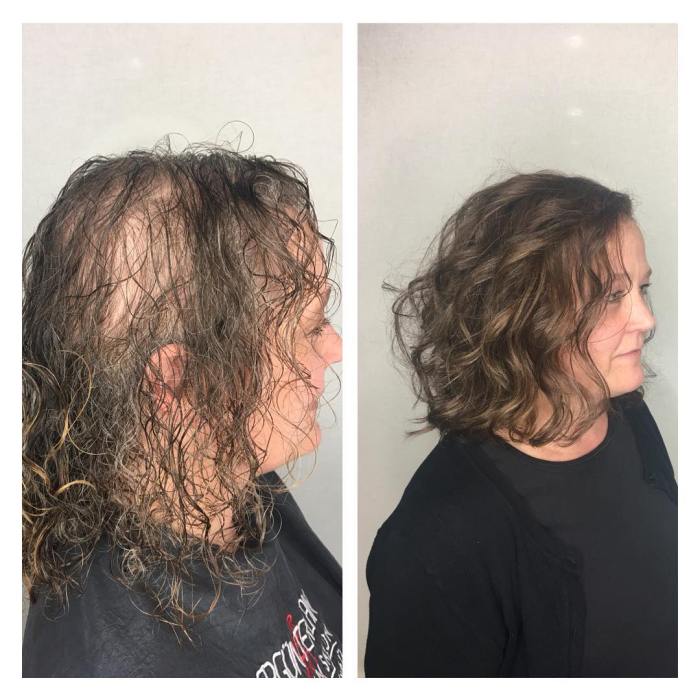Hairstyle for Thin Hair Women A Comprehensive Guide
Understanding Thin Hair
Hairstyle for thin hair women – Thin hair is a common concern for women, affecting both the appearance and confidence. It’s crucial to understand the different types and causes to select appropriate hairstyles and care routines.
Types of Thin Hair
Thin hair isn’t a single entity; it encompasses varying characteristics. Fine hair refers to the individual strands’ diameter – they are naturally thin. Thin hair refers to the overall density, meaning fewer strands per square inch of scalp. Sparse hair is a more severe condition where hair loss is significant, leading to visibly thinner coverage.
Causes of Thin Hair in Women
Several factors contribute to thin hair. Genetics play a significant role, determining hair follicle size and growth cycle. Hormonal changes, particularly during pregnancy, menopause, or due to thyroid issues, can impact hair density. Nutritional deficiencies, stress, certain medical conditions, and aggressive hair styling techniques also contribute to hair thinning.
Factors Influencing Hair Thickness and Volume
Beyond genetics and health, lifestyle choices affect hair thickness. A balanced diet rich in protein and essential nutrients supports healthy hair growth. Proper scalp care, avoiding harsh chemicals, and minimizing heat styling damage are also crucial for maintaining volume and thickness.
Assessing Hair Type and Density
To select the most flattering hairstyle, assess your hair type and density. Part your hair in several sections and examine the number of strands visible at the scalp. Consider the texture (fine, medium, coarse) and the overall density (thin, medium, thick). This self-assessment guides you towards suitable styles.
Hairstyle Choices for Thin Hair
Numerous hairstyles can create the illusion of thicker, fuller hair. The key is to choose styles that add volume and movement, complementing your face shape and hair texture.
Flattering Hairstyles for Thin Hair
Hairstyle selection depends on hair length. Short styles often create the illusion of more volume, while medium and long styles benefit from strategic layering and styling techniques.
| Hairstyle | Description | Face Shape Suitability | Volume Enhancement |
|---|---|---|---|
| Pixie Cut | Short, choppy layers create texture and volume. | Oval, heart, diamond | High |
| Long Layered Cut | Long layers add movement and prevent hair from looking flat. | Oval, round | Medium |
| Shoulder-Length Bob | Blunt or slightly layered bob adds fullness and sophistication. | Oval, square, round | Medium |
| A-Line Bob | Shorter layers in the back and longer layers in the front create volume and shape. | Most face shapes | High |
Hairstyles that Add Volume
Styles with layers, strategically placed bangs, and texturizing techniques are ideal for creating volume. Avoid styles that pull hair tightly back, as this can emphasize thinness.
Using Layers, Bangs, and Texturizing Techniques
Layers add movement and prevent hair from looking limp. Side-swept bangs can soften facial features and create a fuller appearance. Texturizing techniques, like feathering or point cutting, add volume and dimension.
Styling Techniques and Products

Source: latest-hairstyles.com
Proper styling techniques and the right products are essential for achieving maximum volume with thin hair. Avoid harsh treatments that can further damage already delicate strands.
Styling Thin Hair for Maximum Volume, Hairstyle for thin hair women
Start with volumizing mousse or root lift spray applied to damp hair. Use a round brush to lift hair at the roots while blow-drying. For added volume, consider using hot rollers or a curling iron to create soft waves or curls.
Volumizing Products
Mousses add body and hold without stiffness. Sprays offer targeted volume at the roots. Serums provide shine and hydration without weighing hair down. Choose products specifically formulated for fine or thin hair to avoid unnecessary weight.
Using Heat Styling Tools
Use heat protectant spray before using any heat styling tools. Apply heat in sections, focusing on the roots for lift. Avoid excessive heat or prolonged exposure, which can damage hair.
Hair Care Products for Thin Hair
- Volumizing shampoo and conditioner
- Lightweight leave-in conditioner
- Root lift spray
- Volumizing mousse
- Hair oil (used sparingly)
Hair Color and Thin Hair

Source: squarespace-cdn.com
Hair color can significantly impact the perception of hair thickness. Strategic coloring techniques can create depth and dimension, making hair appear fuller.
Hair Color’s Influence on Thickness
Darker shades can make hair look denser, while lighter shades can sometimes make it appear finer. However, the right highlighting or lowlighting technique can add depth and dimension, enhancing the illusion of thickness.
Highlights and Lowlights for Volume
Subtle highlights and lowlights strategically placed throughout the hair can add depth and dimension, creating the illusion of thicker hair. Avoid overly chunky highlights or harsh contrasts, which can draw attention to thin areas.
Hair Coloring Techniques for Thin Hair
Balayage and ombre techniques are gentler on thin hair than full-head color. They add dimension without the harshness of traditional highlights or all-over color. Always use color-safe products to minimize damage.
Choosing Hair Colors
Consider your skin tone when choosing a hair color. Warm tones generally complement warmer skin tones, while cool tones complement cooler skin tones. Consult a professional stylist for personalized recommendations.
Finding the right hairstyle for thin hair can be challenging, but there are many stylish options available. For women over 50 with fine hair, a shaggy cut can add volume and texture, and you can find inspiration for these looks by checking out this helpful resource on older woman shaggy hairstyles for fine hair over 50. Ultimately, the key is to choose a style that complements your face shape and lifestyle, regardless of age.
Maintaining Healthy Thin Hair
Maintaining the health of thin hair involves a holistic approach, encompassing diet, scalp care, and mindful styling practices.
Tips for Maintaining Healthy Thin Hair
- Eat a balanced diet rich in protein and essential nutrients.
- Minimize heat styling and chemical treatments.
- Use gentle hair care products.
- Massage your scalp regularly to stimulate blood flow.
- Avoid tight hairstyles that pull on the hair.
Dietary Recommendations
Include foods rich in protein (lean meats, fish, beans, lentils), iron (spinach, red meat), zinc (nuts, seeds), and biotin (eggs, sweet potatoes) in your diet. These nutrients support healthy hair growth.
Scalp Care and Hair Washing Techniques
Wash your hair with a gentle, sulfate-free shampoo. Avoid over-washing, which can strip hair of its natural oils. Massage your scalp gently while washing to stimulate blood flow.
Hair Supplements and Treatments
Hair supplements containing biotin, collagen, and other nutrients may support hair growth, but consult a doctor before taking them. Professional hair treatments like platelet-rich plasma (PRP) therapy can stimulate hair follicle growth but are costly and may not be effective for everyone.
Illustrative Examples of Hairstyles
Several hairstyles are particularly effective for enhancing the appearance of thin hair. These examples highlight key features and styling considerations.
Pixie Cut for Thin Hair
A pixie cut with textured layers creates volume and movement, minimizing the appearance of thinness. The short length reduces weight, allowing for easy styling. A slightly longer fringe can soften facial features and add fullness to the front.
Long Layered Hairstyle for Thin Hair
Long layered hairstyles with face-framing layers add movement and prevent the hair from looking flat. Long layers create visual interest and avoid a heavy, weighed-down look. Styling products like volumizing mousse and texturizing spray enhance the layers’ movement.
Bob Hairstyle with Subtle Waves
A bob with subtle waves adds volume and texture without appearing overly styled. The waves create movement and prevent the hair from looking limp. A volumizing mousse or texturizing spray can be used to create the waves and maintain their shape throughout the day.
Key Features of Hairstyles

Source: fashiondigger.com
- Pixie Cut: Short, layered, textured, easy to style.
- Long Layered Hairstyle: Long, layered, movement, requires styling products.
- Bob with Subtle Waves: Medium length, subtle waves, adds volume, requires styling products.
Clarifying Questions: Hairstyle For Thin Hair Women
Can I use heat styling tools every day?
Overuse of heat styling tools can damage thin hair. Aim for 2-3 times a week maximum, and always use a heat protectant spray.
How often should I wash my thin hair?
Washing too frequently can strip natural oils, leading to dryness and more visible thinness. Aim for every other day or every two days, depending on your scalp’s oil production.
What are some natural ways to add volume?
Rinsing with cold water, using volumizing shampoos and conditioners, and incorporating scalp massages can all help boost volume naturally.
Are there any specific vitamins that help with hair growth?
Biotin, vitamin D, and iron are often associated with healthy hair growth. Consult a doctor or nutritionist to determine if supplementation is necessary.












